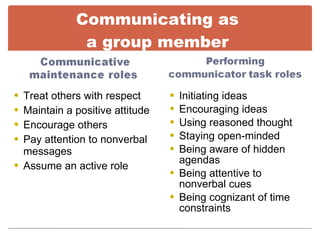Chapter 9 and 10: Groups
- 1. CHAPTERS 9 and 10 Groups
- 2. GROUPS What are they good for?
- 3. Advantages Disadvantages Risky shift phenomena Many viewpoints Challenging of ideas before they are put into place Greater commitment to the decision reached Time-consuming Individuality sacrificed Groupthink Social loafing
- 4. Types of groups Work teams Study Groups Support Groups Committees Media conferences Focus groups Families Public meetings Town meetings
- 6. What motivated you to choose your group members?
- 7. Group operations Group comes together to accomplish a task
- 8. What conflicts arose as the group decided what to draw and how / who would draw it?
- 9. Group operations Causes of conflict Power struggle Personal problems with the rules of operation Personality conflicts If storming doesn’t happen make sure it’s not because of groupthink
- 10. How did you resolve these conflicts and start drawing?
- 11. Group operations Group norms are established
- 12. Group operations Group comes together Settlement of norms, methods, objectives, leadership, etc. Members feel commitment to the group
- 13. How long did it take you before you began drawing? Why? Are you all satisfied with the drawing?
- 14. Group operations Action stage Group works towards goals and makes decisions Decision-making is influenced by the task and maintenance dimensions
- 15. Making Group Decisions Formulate an agenda Agendas may vary based on the task at hand Voting The method you select can affect the outcome Consensus Majority Plurality Part-of-the-whole
- 16. Communicating as a group member Treat others with respect Maintain a positive attitude Encourage others Pay attention to nonverbal messages Assume an active role Initiating ideas Encouraging ideas Using reasoned thought Staying open-minded Being aware of hidden agendas Being attentive to nonverbal cues Being cognizant of time constraints
- 17. How / why did the group disperse?
- 18. Group operations All groups need closure
- 19. More on group participants
- 20. The Group Participant Enthusiastic Intelligent Self-reliant Communicates with other members Actively engages in the work of the group Critically assesses group decisions Contributes creative ideas
- 21. The Group Participant All members are responsible for outcomes All members should be knowledgeable Dominators can destroy the group It’s your right NOT to participate. But you agree to give up your responsibilities and your privileges if you don’t Participants should recognize that rejection of their ideas is not a rejection of them as people Prejudices and beliefs may need to be set aside, but don’t let bullies force you into doing this
- 22. Dealing with Difficult Group Members Impossible members can be expelled, ignored or permitted to speak, but no one has to listen Don’t try to appease them Resist the temptation to react reciprocally Don’t give them with a soapbox Try to convert the disruption into a contribution Confront the person directly Separate yourself from the person
- 23. Teacher Notes
- 24. Teacher notes SONA Comments Informative Briefs Grades YouTube Group assignments Community office hours Friday
- 25. Teacher notes Friday (a.k.a. Group leadership blog post) What type of leader is she/he? What type of leadership power does she/he exert? Your favorite characteristics of her /him as a leader? Since not all leaders or role models are perfect… a flaw

























